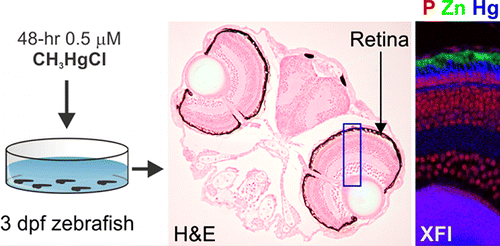Scientists explore how mercury could interfere with vision

(Phys.org) —People have long heard that carrots are good for their eyesight, and strong evidence exists that eating fish also provides health benefits.
But low levels of mercury, like the kind often found in fish, have been shown to target photoreceptors, which could affect eyesight health. A new study takes the closest look yet at the potential connection between mercury and eyesight health.
A team of U.S. and Canadian scientists has used X-ray imaging techniques to study in unprecedented detail how methylmercury, an organic form of mercury pollution found in aquatic systems, concentrates in the eye tissue of zebrafish. Scientists commonly use these fish to model biological reactions because of genetic similarities to humans.
"Researchers are studying the potential effects of low level chronic exposure to methylmercury, which is of global concern due to methylmercury presence in fish, but the message that I want to get across is that such exposures may negatively affect vision," said Gosia Korbas, BioXAS staff scientist at the Canadian Light Source (CLS ) and lead author of the study published in the August issue of the journal ACS Chemical Biology. "Our study clearly shows that we need more research into the direct effects of methylmercury on the eye."
The research was conducted by scientists from the Advanced Photon Source at the U.S. Department of Energy's Argonne National Laboratory, the CLS and the University of Saskatchewan.
"The X-ray fluorescence capabilities at the APS enabled the team to identify the cellular distribution of mercury and other elements at unprecedented spatial resolution," said Barry Lai, a physicist in Argonne's X-ray Science Division and an author on the paper. "This showed that methylmercury targets the eye, at least in zebrafish, and that long-term accumulation may significantly damage vision, an effect that has until now has flown under the radar."
More than one billion people worldwide rely on fish as an important source of animal protein, states the United Nations Food and Agriculture Organization. And while fish provide slightly over 7 percent of animal protein in North America, in Asia they represent about 23 percent of consumption.
Humans consume low levels of methylmercury by eating fish and seafood. Methylmercury compounds specifically target the central nervous system, and among the many effects of their exposure are visual disturbances, which were previously thought to be solely due to methylmercury-induced damage to the brain visual cortex. However, after using powerful synchrotron X-rays to study methylmercury-poisoned zebrafish larvae, scientists have found that methylmercury may also directly affect vision by accumulating in the retinal photoreceptors, i.e. the cells that respond to light in our eyes.
Korbas says the results of this experiment show quite clearly that methylmercury localizes in the part of the photoreceptor cell called the outer segment, where the visual pigments that absorb light reside.
"There are many reports of people affected by methylmercury claiming a constricted field of vision or abnormal colour vision," Korbas said. "Now we know that one of the reasons for their symptoms may be that methylmercury directly targets photoreceptors in the retina."
The team used two X-ray fluorescence imaging beamlines (2-ID-D and 2-ID-E), at the facility near Chicago, as well as the scanning X-ray transmission beamline (STXM) at the CLS in Saskatoon, Canada.
After exposing zebrafish larvae to methylmercury chloride in water, the team was able to obtain high-resolution maps of elemental distributions, and pinpoint the localization of mercury in the outer segments of photoreceptor cells in both the retina and pineal gland of zebrafish specimens. The results of the research were published in ACS Chemical Biology under the title "Methylmercury Targets Photoreceptor Outer Segments".
Korbas said zebrafish are an excellent model for investigating the mechanisms of heavy metal toxicity in developing vertebrates. One of the reasons for that is their high degree of correlation with mammals. Recent studies have demonstrated that about 70 per cent of protein-coding human genes have their counterparts in zebrafish, and 84 percent of genes linked to human diseases can be found in zebrafish.
Still, more research is needed to confirm that methylmercury targets human eye tissue in the same way it targets eye tissue in zebrafish larvae. Scientists plan to continue the studies.
More information: pubs.acs.org/doi/abs/10.1021/cb4004805
Journal information: ACS Chemical Biology
Provided by Argonne National Laboratory


















